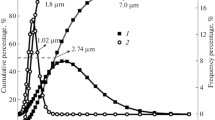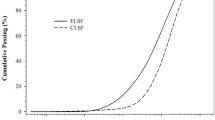Abstract
To achieve high value-added resource utilization of solid waste and reduce the cost of rubber manufacturing, this study utilizes finely structured municipal sludge (MS) with small particle size and abundant organic matter as the main raw materials. Through organic surface modification, rubber reinforcing fillers with surface affinity and compatibility are prepared. The effect of the amount of coupling agent bis-(triethoxysilyl-propyl)-tetrasulfide (Si69) on the properties of modified sludge powder (Si69-MS) reinforced styrene butadiene rubber (SBR) and its reinforcing mechanism were also studied. The results showed that when the mass fraction of Si69 was 1.5% of the MS, the adhesion work between Si69-MS and SBR increased from 88.34 to 101.42 mJ m−2, and the interfacial tension decreased from 25.45 to 0.34 mJ m−2. The tensile strength of the composite SBR reached 14.86 MPa, and the elongation at break reached 1829.1%. These findings indicate that the increased interface affinity between Si69-MS and the surface of SBR improves its dispersion within the SBR matrix, promoting the formation of a highly elastic composite rubber.









Similar content being viewed by others
Data availability
The data presented in this study are available on request from the corresponding author.
References
Hu Y, Zhao Z, Yang L et al (2014) Three factors of rubber reinforce materials and its development. Polym Bull 2:36–40
Intiya W, Thepsuwan U, Sirisinha C et al (2016) Possible use of sludge ash as filler in natural rubber. J Mater Cycles Waste Manag 19(2):774–781
Wang X, Wu L, Yu H et al (2021) Analysis of effect of modification of silica and carbon black co-filled rubber composite on mechanical properties. E-Polymers 21(1):279–288
Zaborski M, Kunert A, Pietrasik J et al (2007) Intercalated montmorillonites as fillers for acrylonitrile-butadiene rubber. Rubber Chem Technol 80(2):279–295
Zhang Z, Xing L, Xu Y (2014) Advances on research and application of attapulgite in rubber as reinforcing fillers. Bull Chin Ceram Soc 33(12):3235–3238
Tagliaro I, Cobani E, Carignani E et al (2022) The self-assembly of sepiolite and silica fillers for advanced rubber materials: The role of collaborative filler network. Appl Clay Sci 218:106383
Maan A, Niyogi UK, Singh AK et al (2015) Studies on effect of a silane coupling agent (TESPT) on the properties of fly ash-natural rubber composite. J Polym Mater 32(1):45–55
Gao N, Sipra AT, Quan C (2020) Thermogravimetric analysis and pyrolysis product characterization of municipal solid waste using sludge fly ash as additive. Fuel 281:118572
Liu Q, Tang Q, Zhao W et al (2022) Ultrafine grinded and silane grafted iron ore tailings as reinforcing filler of styrene butadiene rubber. Materials (Basel) 15(5):1756
Barana D, Orlandi M, Salanti A et al (2019) Simultaneous synthesis of cellulose nanocrystals and a lignin-silica biofiller from rice husk: application for elastomeric compounds. Ind Crops Prod 141:111822
Xue B, Wang X, Sui J et al (2019) A facile ball milling method to produce sustainable pyrolytic rice husk bio-filler for reinforcement of rubber mechanical property. Ind Crops Prod 141:111791
Torres LF, McCaffrey Z, Washington W et al (2021) Torrefied agro-industrial residue as filler in natural rubber compounds. J Appl Polym Sci 138(28):50684
Xiaoqing L, Xinmin S, Zhonghang F et al (2021) Study on reinforcement of natural rubber by kaolin. Trop Agric Sci Technol 44(04):21–24
Erwei L, Hao L, Guocheng L et al (2020) Preparation of rubber filler by tungsten-molybdenum tailings from Yechangping in Henan province. Bull Chin Ceram Soc 39(01):225–232
Yunhua Q, Yeling J (2004) The filling of the rubber with modified fly ash. Multipurp Util Miner Resour 06:44–47
Wang J, Xiong Z, Shi M (2021) Review on sludge to energy utilization technology. Mod Chem Ind 41(7):99–102
Chun-lai ZHU (2009) Application effect of municipal sewage sludge organic-inorganic compound fertilizer on spring wheat in Eastern Qinghai province. Hubei Agric Sci 48(11):2693–2695
Wu K, Hu Y, Zhang L et al (2022) Promoting the sustainable fabrication of bricks from municipal sewage sludge through modifying calcination: microstructure and performance characterization. Constr Build Mater 324:126401
Franus M, Barnat-Hunek D, Wdowin M (2016) Utilization of sewage sludge in the manufacture of lightweight aggregate. Environ Monit Assess. https://doi.org/10.1007/s10661-015-5010-8
Tan W-F, Wang L-A, Huang C et al (2012) Utilization of municipal solid waste incineration fly ash in lightweight aggregates. J Cent S Univ 19(3):835–841
He Y, Shu W, Liao X et al (2015) Preparation of sludge-stalk based activated carbon and its adsorption of cod in leachate. Chin J Environ Eng 9(4):1663–1669
Kuang S, Nie Y (2006) Preliminary study on processing oil-based calcium carbonate mud (OBCCM) into rubber fillers. Environ Eng 24(4):45–47
Ismail H, Rusli A, Azura AR (2006) Study of fatigue life and filler interaction of paper sludge filled epoxidized natural rubber (ENR) and maleated natural rubber (MNR) composites. J Polym Environ 15(1):67–74
Di J, Perwuelz A, Gueguen V (2001) The surface energy of pet fabrics coated with silicone. J Text Inst 92(2):184–192
Zhang C, Tang Z, Guo B et al (2018) Significantly improved rubber–silica interface via subtly controlling surface chemistry of silica. Compos Sci Technol 156:70–77
Dinesh PS (2019) Bagasse fiber reinforced functionalized ethylene propylene rubber composites by Palsule process. J Nat Fibers 18(11):1637–1649
Thongsang S, Sombatsompop N (2006) Effect of NaOH and Si69 treatments on the properties of fly ash/natural rubber composites. Polym Compos 27(1):30–40
Zhang Y, Zhang S, Liu Q et al (2012) Wet ball-milling modification of kaolin and mechanical properties of its rubber composites. New Chem Mater 40(11):104–106
Sombatsompop N, Wimolmala E, Markpin T (2007) Fly-ash particles and precipitated silica as fillers in rubbers. II. Effects of silica content and Si69-treatment in natural rubber/styrene–butadiene rubber vulcanizates. J Appl Polym Sci 104(5):3396–3405
Shen H, Wang Z (2018) Surface modification of steel slag and its application in compounded rubber. Mater Rev 32(3B):1000–1003 (1019)
Miedzianowska J, Maslowski M, Rybinski P et al (2020) Properties of chemically modified (selected silanes) lignocellulosic filler and its application in natural rubber biocomposites. Materials (Basel) 13(18):4163
Oo HM, Karin P, Chollacoop N et al (2021) Physicochemical characterization of forest and sugarcane leaf combustion’s particulate matters using electron microscopy, EDS, XRD and TGA. J Environ Sci 99(01):296–310
Tang Q, Wang F, Guo H et al (2015) Effect of coupling agent on surface free energy of organic modified attapulgite (OAT) powders and tensile strength of OAT/ethylene-propylene-diene monomer rubber nanocomposites. Powder Technol 270:92–97
Wu JH, Lin SB, Lin JM et al (2004) Interface effect in the silicone rubber/mineral powder composites. Compos Interfaces 11(2):145–152
Zhou W, Yu D, Wang C et al (2008) Effect of filler size distribution on the mechanical and physical properties of alumina-filled silicone rubber. Polym Eng Sci 48(7):1381–1388
Acknowledgements
This research was funded by the National Key Research and Development Program of China, grant number: 2019YFC1904601. The experiments were carried out at the Hebei University of Technology.
Author information
Authors and Affiliations
Contributions
Writing—original draft preparation, WZ; validation, YH; formal analysis, WZ and YH; investigation, WZh, YH, CL and, YQ; conceptualization, writing—review and editing, QT; supervision and project administration, XD, and JL. All authors have read and agreed to the published version of the manuscript.
Corresponding author
Ethics declarations
Conflict of interest
The authors declare that they have no competing interests.
Ethical approval
No ethical approval was required for this research as it did not involve human tissue or any other parts of living organisms.
Additional information
Publisher's Note
Springer Nature remains neutral with regard to jurisdictional claims in published maps and institutional affiliations.
Rights and permissions
Springer Nature or its licensor (e.g. a society or other partner) holds exclusive rights to this article under a publishing agreement with the author(s) or other rightsholder(s); author self-archiving of the accepted manuscript version of this article is solely governed by the terms of such publishing agreement and applicable law.
About this article
Cite this article
Zhao, W., Tang, Q., Liang, C. et al. A novel route for styrene–butadiene rubber reinforcement based on the interface effect of sludge modification. J Mater Cycles Waste Manag 25, 3747–3757 (2023). https://doi.org/10.1007/s10163-023-01792-8
Received:
Accepted:
Published:
Issue Date:
DOI: https://doi.org/10.1007/s10163-023-01792-8




